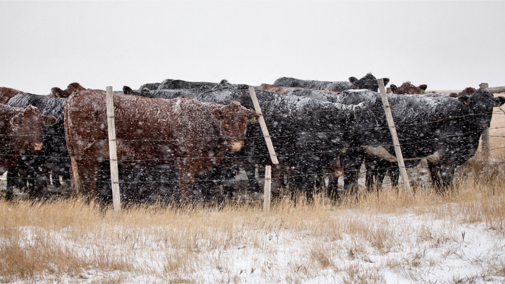Cold Stress in Cattle
While daytime temperatures have been mild so far this December, bitter cold and negative wind chills are undoubtedly on the horizon. This is a good time to consider how we can best protect our cattle since livestock performance and survival is affected by wind and temperature.
The lower critical temperature, or the threshold at which cattle must use energy to maintain their body temperature, is 19°F for cattle with a dry hair coat, and 53°F for cows with a wet hair coat. Providing animals shelter in bad weather can help keep coats dry and limit wind chill effects, both of which will work to minimize the impact of the cold. Shelter can also help in other ways. Calving success can increase by 2% behind a windbreak, according to a Kansas study. In Montana feedlots during severe winters, cattle behind windbreaks gained 10.6 lbs. more than cattle that did not have windbreaks.
Cold stress increases a cow’s energy requirement which, if not met, can pull down body condition. A general rule of thumb we can use is that for every degree of cold stress a cow faces, they increase their energy requirements by 1%. In extreme cold, even high-quality hay can’t meet the increased energy demands. Corn is a great high energy option, but we need to be careful to work it up in a diet slowly. Pair it with free choice hay for fill and make sure not to give too much at once to animals whose rumen hasn’t shifted yet.
Finally, it is important to remember that lactating cows have a much greater energy requirement than pregnant cows. Because of this, cold stress can reduce a lactating cow’s body condition more rapidly, so it is advisable to increase their energy intake before loss of condition is observed. If you have questions about adjusting animal diets to address cold weather stress, your local extension office is a great place to start.
Testing and Feeding Tobacco-brown Hay and Silage
Did difficult weather this year cause your hay to be baled too wet or silage chopped too dry? Now that hay and silage has heated and turned brown, how should you feed these forages?
Hay baled too wet or silage chopped to dry can get excessively hot and cause certain chemical reactions to occur. These chemical reactions and the heat that produces them will darken your forage and make it smell sweet like caramel.
Livestock often find such hay or silage very palatable. But the chemical reaction that caused this heat-damaged forage reduces its energy value and also makes some of the protein become indigestible. Unfortunately, tests for crude protein do not distinguish between regular crude protein and this heat-damaged protein. As a result, your forage test can mislead you into thinking you have more usable protein in your forage than actually is there.
If your forage test is done using NIR, heat-damaged protein may be one of the analyses reported. If the heat-damaged protein is high enough, the test also will report an adjusted crude protein that is different from the regular crude protein. However, the NIR test for heat-damage may not be accurate enough for you if your ration contains a lot of this forage. In these cases where a large amount of heat-damaged protein is suspected, request from your lab a chemical analysis for heat-damaged protein. This will ensure the amount of head damage is measured correctly and allow you to adjust the amount of crude protein your forage actually will provide to your animals.
Forage tests can tell us a lot about the nutrient supplying ability of our forages. But we need to make sure we conduct the right tests and then use the results wisely.

